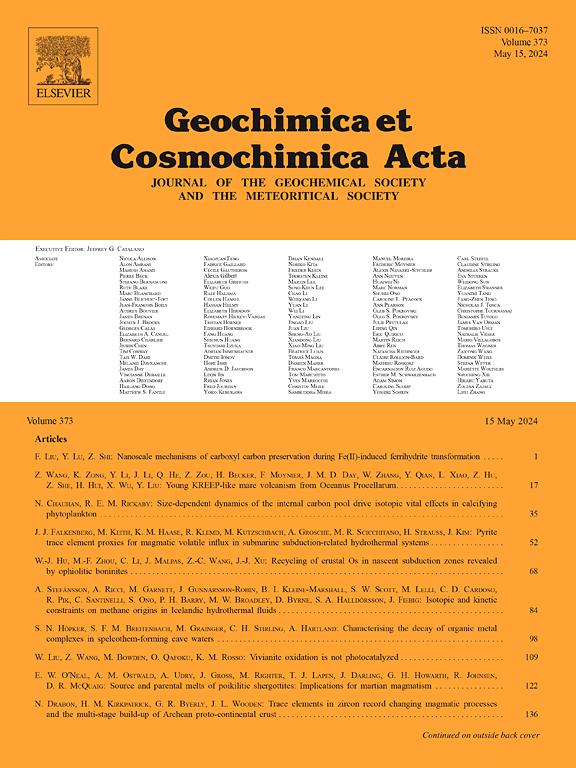Radon and radium isotope signatures on a massive ice- and permafrost-rich coastline
IF 5
1区 地球科学
Q1 GEOCHEMISTRY & GEOPHYSICS
引用次数: 0
Abstract
Rapid warming in the Arctic is degrading permafrost and massive ice deposits, which releases solutes previously trapped in ice and frozen soils into groundwater, rivers, and the coastal ocean. Radium and radon isotopes are enriched in groundwaters and may therefore have utility as tracers for the delivery of permafrost-derived solutes to the ocean, particularly if massive ice- or permafrost-derived meltwaters have a distinct isotopic ratio. The ratio of radium isotopes within massive ice deposits can also be used to constrain timescales of ice segregation, as the four isotopes will decay with known rates once removed from contact with sediments. Here we present the first measurements of radium and radon in massive ice deposits along the Beaufort Sea coast in the Northwest Territories, Canada. Measurable levels of short-lived radium and radon isotopes indicate relatively recent ice segregation and/or inputs from sediment grains frozen within the ice lenses; the radium-224/radium-228 ratio is used to identify ice samples that must have experienced segregation within the last five years, and desorption experiments provide evidence that sediment within the ice can support the radium activities observed in older ice. Short- to long-lived isotope ratios were low in ice and increased in meltwater and groundwater, while coastal ocean ratios were similar to those of the nearby Mackenzie River. Thus, we find that the radium isotope ratio of massive ice is not preserved during transport, and the river is the main control on the coastal radionuclide distribution in this region. A distinctly low (<1) radium-224/radium-228 ratio was measured in massive ice deposits, similar to previous observations in permafrost, suggesting that this low ratio may be characteristic of cryogenic environments.
氡和镭的同位素特征在一个巨大的冰和永久冻土丰富的海岸线
北极地区的快速变暖正在使永久冻土和大量的冰沉积物退化,这些冰沉积物将以前困在冰和冻土中的溶质释放到地下水、河流和沿海海洋中。镭和氡同位素在地下水中富集,因此可作为示踪剂,用于向海洋输送来自永久冻土的溶质,特别是如果大量的冰或来自永久冻土的融水具有明显的同位素比率。大量冰沉积物中镭同位素的比例也可以用来限制冰分离的时间尺度,因为一旦与沉积物接触后,这四种同位素将以已知的速率衰变。在这里,我们展示了在加拿大西北地区波弗特海岸的大量冰沉积物中镭和氡的第一次测量。可测量的短寿命镭和氡同位素水平表明相对较近的冰分离和/或冰透镜内冻结的沉积物颗粒的输入;镭-224/镭-228比值用于鉴定在过去五年内必须经历分离的冰样,解吸实验提供的证据表明,冰内沉积物可以支持在较老的冰中观察到的镭活动。短寿命和长寿命的同位素比率在冰中较低,在融水和地下水中增加,而沿海海洋的比率与附近的麦肯齐河相似。因此,我们发现块状冰的镭同位素比值在运输过程中没有被保存下来,河流是控制该地区沿海放射性核素分布的主要因素。在巨大的冰沉积物中测量到明显低(<1)的镭-224/镭-228比率,与以前在永久冻土中的观测结果相似,表明这种低比率可能是低温环境的特征。
本文章由计算机程序翻译,如有差异,请以英文原文为准。
求助全文
约1分钟内获得全文
求助全文
来源期刊

Geochimica et Cosmochimica Acta
地学-地球化学与地球物理
CiteScore
9.60
自引率
14.00%
发文量
437
审稿时长
6 months
期刊介绍:
Geochimica et Cosmochimica Acta publishes research papers in a wide range of subjects in terrestrial geochemistry, meteoritics, and planetary geochemistry. The scope of the journal includes:
1). Physical chemistry of gases, aqueous solutions, glasses, and crystalline solids
2). Igneous and metamorphic petrology
3). Chemical processes in the atmosphere, hydrosphere, biosphere, and lithosphere of the Earth
4). Organic geochemistry
5). Isotope geochemistry
6). Meteoritics and meteorite impacts
7). Lunar science; and
8). Planetary geochemistry.
 求助内容:
求助内容: 应助结果提醒方式:
应助结果提醒方式:


